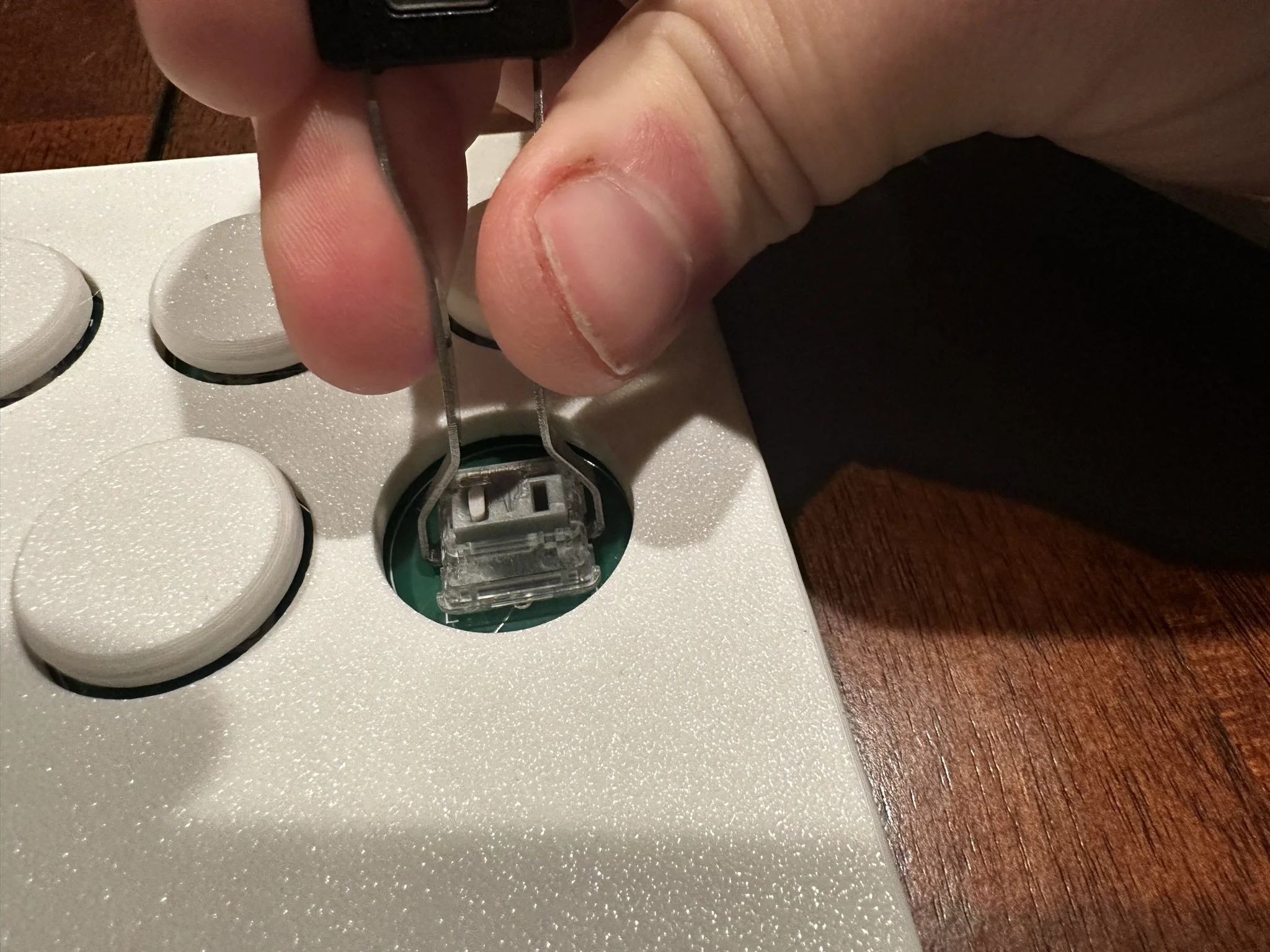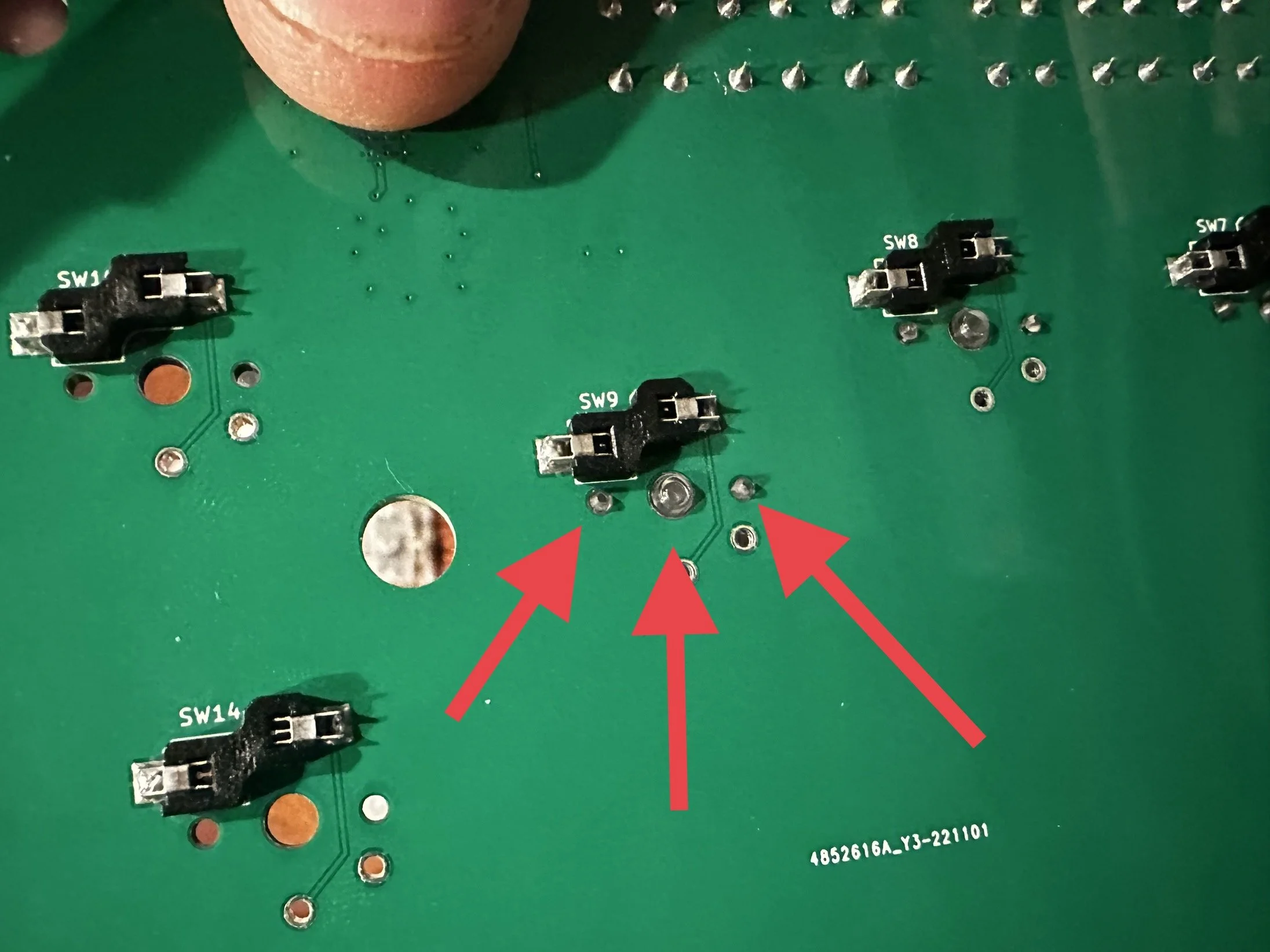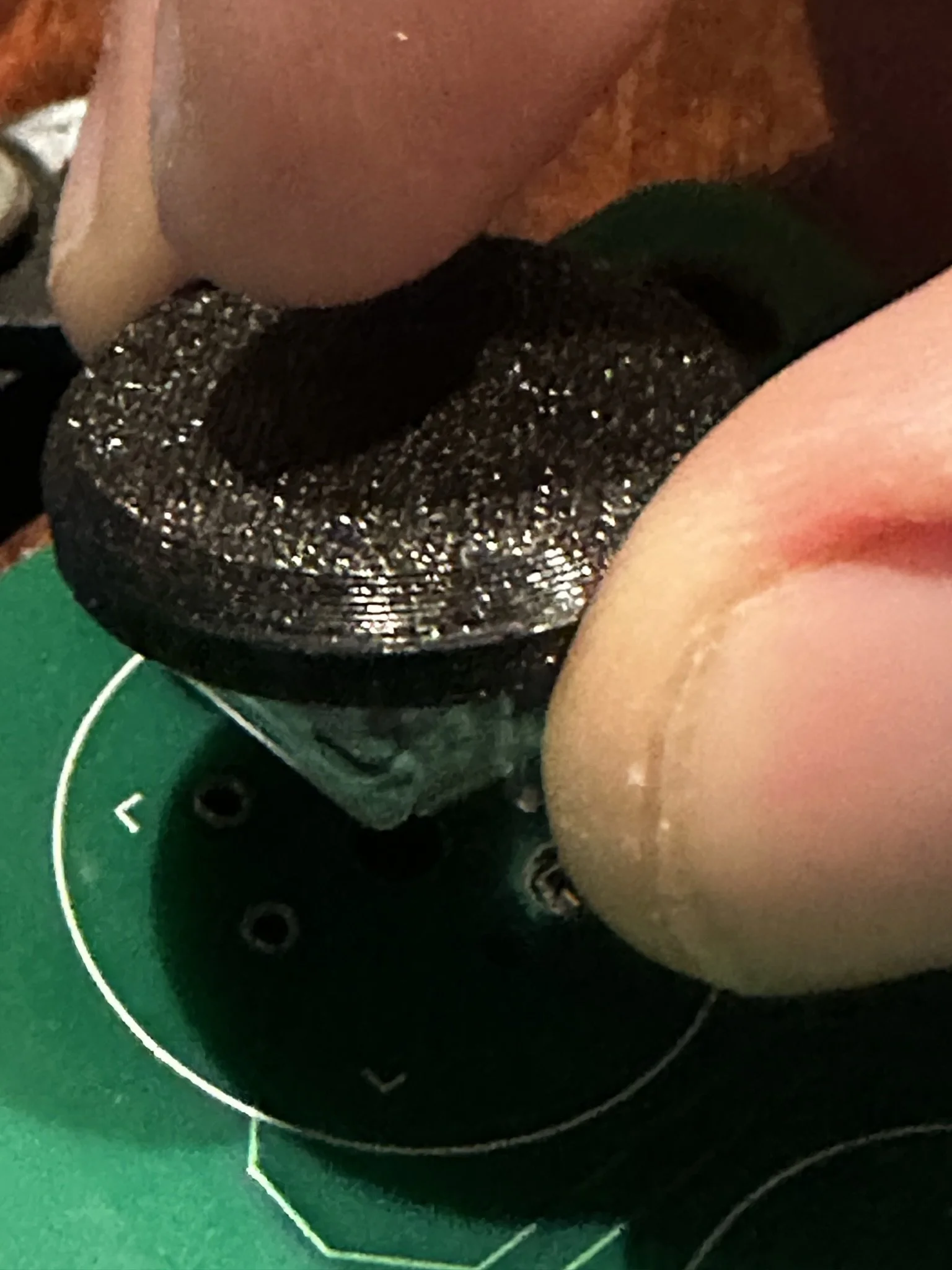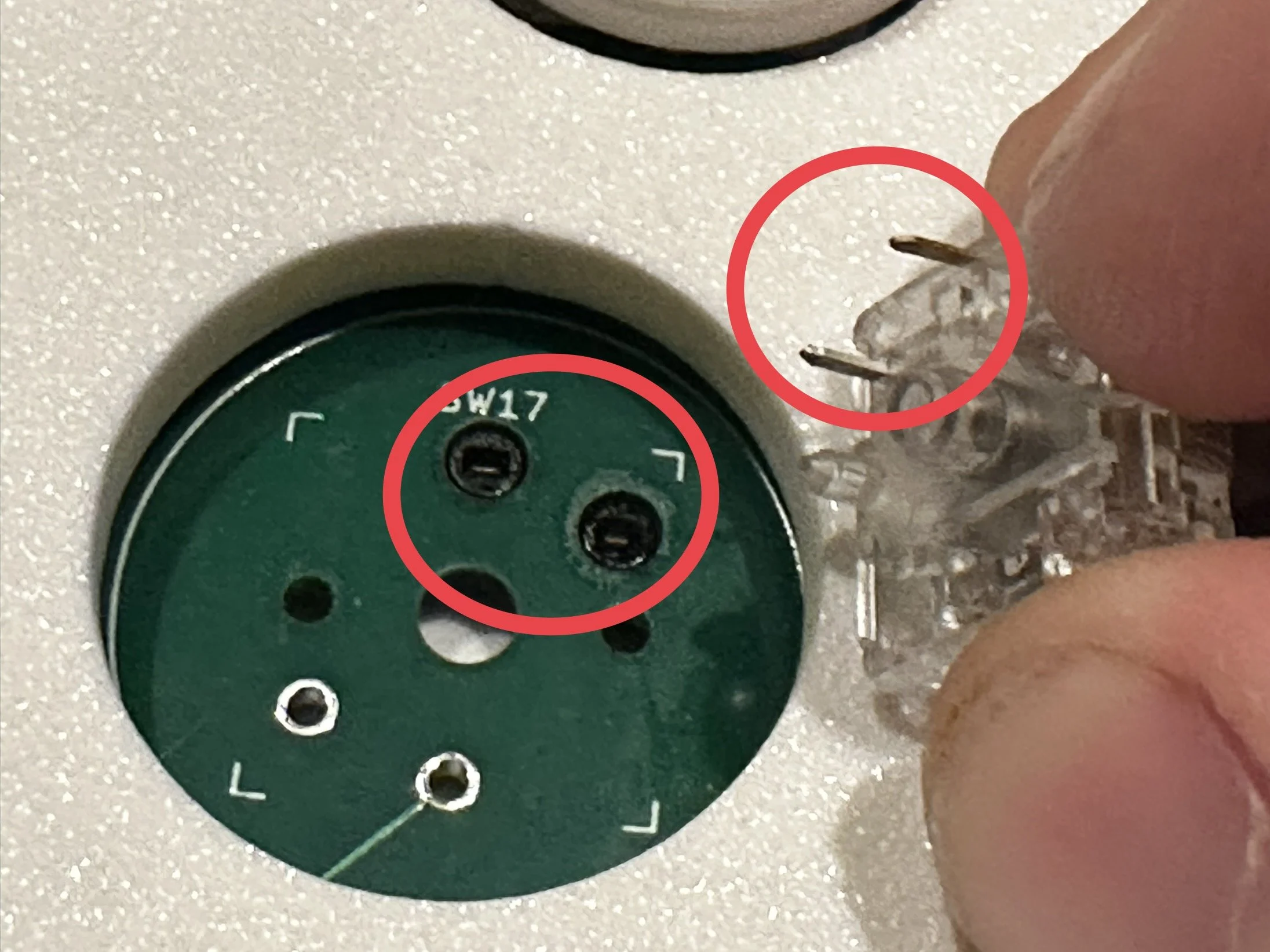Faust Manual
Overview
The SGF FAUST is a high performance low cost stickless controller running the GP2040-CE firmware (https://gp2040-ce.info/) and is compatible with many modern consoles and computers. It comes pre-configured with all necessary firmware and SOCD cleaning.
Firmware updating is not recommended unless you need a new GP2040-CE feature. We never ship with firmware with any known issues, and updating firmware can introduce instability if done improperly or impact previous feature sets.
For questions about software configuration, firmware updates, and software support, please refer to the GP2040-CE documentation at https://gp2040-ce.info/#/usage
Layout

Changing Input Method (PC/Switch/PS3/PS4/PS5)
Using the layout as noted above, hold the following buttons while plugging in the controller to change the input method. Note: this is saved across plug/unplug cycles.
Cross (X) - Switch
Circle - Xinput/PC
Square - DirectInput/PS3
Triangle - PS4/PS5* See details about PS4/PS5 compatibility
Usage with PS4/PS5
When using with PS4/PS5, the proper input mode must be selected when plugging in (see above). After selecting proper input mode, the PS/HOME button must be pressed to choose the user profile before the controller can be used.
Without the use of a proper authentication device in the USB passthru port (see details below), the controller will time out on PS4/PS5 after approximately 8 minutes of use.
PS5 mode only works with games that support PS4 arcade sticks. This includes all popular fighting games and many others, but not every PS5 game. It does work with every PS4 game when played on PS5.
For the most up-to-date resource on compatible passthru authentication devices, see the GP2040-CE documentation. In general, the following devices can be used for each platform:
| PS4 |
Any licensed PS4 controller/arcade stick Mayflash Magicboots PS4 Mayflash Magic-S Pro 2 Brook Wingman XE2 Any of the devices listed for PS5 below |
| PS5 |
Any licensed PS4 arcade stick only (standard controllers will not work, nor will PS5 licensed devices) Mayflash Magicboots PS4 v1.1 ONLY Mayflash Magic-S Ultimate with beta firmware ONLY Brook Wingman FGC PS5 licensed devices will not work |
3.5mm External Input Port
The 3.5mm port can be used to connect external inputs to the L3 and R3 signals on the controller. Any digital switch can be used. Analog signals are not supported.
To send the button press signal, the switch should connect either the "left" or "right" (depending on whether the switch is L3 or R3) signal to the GROUND signal on the 3.5mm cable. No diodes or resistors are required. Adapters/converters for things like 3.5mm>RCA, 3.5mm>1/4in should work, but we're unable to test all of them.
Please note that tournament rules change often -- you are responsible for ensuring that use of external switches is allowed under your particular tournament rules. Many tournaments will require the use of the lockout switch to remain in compliance.
Lockout Switch
The small switch on the top of the controller near the USB-C port can be used for Tournament Lockout Mode. This mode physically disconnects the 6 option buttons (START, SELECT, HOME, TOUCHPAD, L3, R3) from the controller. This can prevent accidental presses in tournament play, and may allow for those buttons to be remapped to external inputs depending on tournament regulations.
Changing Directional Behavior
Using the layout above, hold the following buttons at any time to change the directional input behavior. Note: this is saved across plug/unplug cycles.
SELECT+START+LEFT - Left Analog Stick Emulation
SELECT+START+RIGHT - Right Analog Stick Emulation
SELECT+START+DOWN - Digital Dpad
Changing SOCD Modes
FAUST ships with Neutral SOCD as the default setting (U+D=none). Other settings can be chosen in the web config or with the following key combinations. Note: this is saved across plug/unplug cycles.
START+HOME+UP - Up Priority (U+D = U)
START+HOME+DOWN - Neutral (U+D = none, default)
START+HOME+LEFT - Last Input Priority (most recently pressed input is active)
Changing RGB LED Patterns
Using the layout above, hold the following buttons at any time to change the RGB LED behavior. Note: this is saved across plug/unplug cycles.
| SELECT + START + SQUARE | Next Animation |
| SELECT + START + CROSS | Previous Animation |
| SELECT + START + TRIANGLE | Brightness Up |
| SELECT + START + CIRCLE | Brightness Down |
| SELECT + START + R1 | Animation Parameter Up |
| SELECT + START + R2 | Animation Parameter Down |
| SELECT + START + L1 | Pressed Parameter Up |
| SELECT + START + L2 | Pressed Parameter Down |
Customizing RGB LED themes
To customize your RGB theme, please see the GP2040-CE documentation.
Shell Disassembly
This section under construction, please come back soon.
Before starting, unplug the device. To open the shell, lift up on the two tabs while pulling the two halves apart.
 After removing the cover, gently remove the PCB from the locating posts. It may be snug, but don’t apply too much pressure.
After removing the cover, gently remove the PCB from the locating posts. It may be snug, but don’t apply too much pressure.
Note: your PCB may be a different color, this is normal.
To reassemble the shell, carefully place the PCB onto the front shell in the correct orientation, and ensure the PCB is seated fully around the alignment pins. This may be a tight fit.
After checking alignment, carefully slide both sides into the rails that secure them and slide them together.

After fully seating the sides, press down on the tabs to be sure that they're fully engaged.

Removing Switches
Without Removing Shell

Insert a small flat screwdriver or similar tool under the button cap and pry it off. It may break off – this is okay, as replacement switches from us should include replacement button caps.

Remove the switch using a switch puller or a pair of pliers. Be careful not to damage the underlying PCB.
After Removing Shell
This method will not damage the button cap, and therefore can be more useful for cleaning or other scenarios where the button cap must be saved.

After removing the PCB from the shell, using a small blunt tool, push the 3 small retention buttons from the back of the PCB out towards the front. (These may be a different color than pictured). Newer revisions only have 1 retention button in the center.

This will loosen the button enough that it can be pulled away from the front side by hand.
After removing the switch from the board, the button cap can be separated from the switch by gently pulling them apart with your fingers.
Installing Switches
This may be done with or without the shell on. Your replacement switches may or may not have button caps pre-installed. If they are not pre-installed, you may insert them into the switch before or after placing the switch on the PCB.

Ensure the two metal pins on the switch are aligned with the two black slots in the PCB, then press the switch onto the PCB firmly.
Note: Your PCB may look different. The black sockets are not always in the same spot.
If the button cap is not already installed, align the legs of the button cap in with the holes in the switch and press it in firmly. Newer switches use a cross-shaped alignment. In either case, just ensure the switch is aligned with the button cap. Tip: If you’re particularly firm while playing or the button feels a bit loose, you can add a very tiny drop of hot glue to the button legs for extra stability.
Configuration
The web configurator can be accessed by holding the START button while plugging in the controller to a PC, then navigating to http://192.168.7.1/ in a browser on the computer. Full reference for configuration options can be found at https://gp2040-ce.info/#/web-configurator. Note that changing values in the configurator may cause functionality issues. It is recommended to only adjust SOCD settings.
